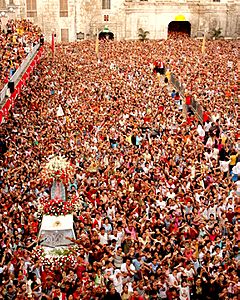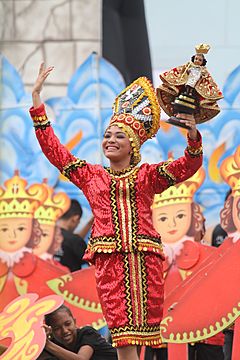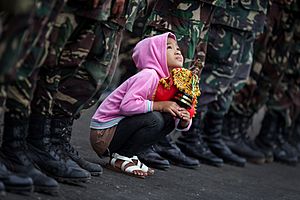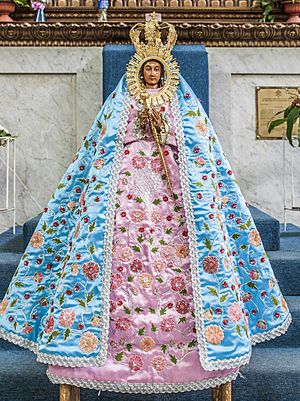Santo Niño de Cebú facts for kids
Quick facts for kids Santo Niño de Cebú |
|
|---|---|
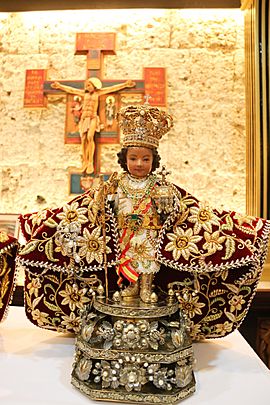
Original image of Señor Santo Niño de Cebú
|
|
| Location | Cebu, Philippines |
| Date | 21 April 1521 |
| Witness | Ferdinand Magellan Antonio Pigafetta Rajah Humabon |
| Type | Wooden statue |
| Approval | Pope Innocent XIII Pope Paul VI Pope John Paul II Pope Francis |
| Shrine | Basílica Menor del Santo Niño |
| Patronage | Cebu, Cebuano people, Filipinos |
| Attributes | crown, sceptre, globus cruciger, dark skin, maroon mantle, gold boots, sash |
| Feast day | Third Sunday in January |
The Santo Niño de Cebú is a very special statue of the Child Jesus for Catholic people in the Philippines. Many Filipino Catholics believe it can perform miracles. It is the oldest Christian item in the Philippines. The famous explorer Ferdinand Magellan gave it as a gift in 1521. He gave it to Rajah Humabon and his wife, Reyna Humamay, when they became Christians.
The statue is made of dark wood and is about twelve inches tall. It shows the Child Jesus looking calm and dressed like a Spanish king. The statue wears a golden crown, holds a special globe, and has different scepters. It also wears fancy clothes and jewelry, which people have given it over hundreds of years.
In 1964, Pope Paul VI officially recognized the statue's importance. He also made its church a special place called a Minor Basilica in 1965. This was to celebrate 400 years of Christianity in the Philippines.
Copies of the Santo Niño statue are found all over the country. It is one of the most loved and recognized Filipino symbols. Every year on January 16, a big dancing festival called Sinulog is held to honor it. Today, the original statue is kept safe behind bulletproof glass inside its chapel at the Basilica del Santo Niño.
Contents
The Santo Niño's Story
The Santo Niño de Cebú statue was made by artists from a place called Flanders. A story says it was based on a vision seen by a holy woman named Teresa of Ávila in the 1500s.
In 1521, a Spanish trip led by Ferdinand Magellan arrived in the Philippines. They were looking for a way to the Spice Islands. On April 7, 1521, they landed in Limasawa, Southern Leyte. There, they met a local leader named Raja Kulambu. He then introduced them to Rajah Humabon, the ruler of Cebu Island, and his wife, Hara Humamay.
On April 14, 1521, Magellan gave them three gifts. These gifts were a statue of Christ, a statue of the Virgin Mary, and the Santo Niño. This happened when Humabon and Humamay were baptized as Christians. Humabon took the Christian name "Carlos," and Humamay was named "Juana." About 500 men and 40 women also became Christians that day.
A few days later, Magellan helped King Carlos in a fight. Magellan attacked Mactan Island, but the people there fought back. Their leader, Lapu Lapu, defended his home. Magellan died on April 27, 1521, in the Battle of Mactan. This was about three weeks after he arrived in the Philippines. After Magellan died, his Spanish friends left the islands.
The next Spanish group arrived on April 27, 1565. They were led by Miguel López de Legazpi. He tried to make friends and start a colony, but the people of Cebu said no. So, Legazpi attacked Cebu and burned down about 1500 homes.
In the burned ruins, a Spanish sailor named Juan Camus found the Santo Niño statue. It was safe inside a pine box. Local stories say that the statue surviving the fire was a miracle. Since then, many people have believed the statue has special powers.
The Santo Niño statue is the oldest Catholic item still existing in the Philippines. A church was built where the statue was found. This church is now called the Basilica Menor del Santo Niño. It is believed to be the oldest church in the Philippines.
The Santo Niño Festival
The festival, known as Fiesta Señor, begins after the Epiphany holiday. It starts with a morning parade where a copy of the Santo Niño statue is carried through the streets. After this, there are nine days of special masses called novenas.
On the last day of the novena, another morning parade takes place. A statue of Nuestra Señora de Guadalupe de Cebú is brought to the Basílica Menor. Then, the Santo Niño statue and the Nuestra Señora statue are taken to a church in Mandaue City. There, they meet the statue of St. Joseph, forming the Holy Family. This journey is called Traslación.
The day before the main feast, the Santo Niño and Nuestra Señora statues return to Cebu City. They travel by boat in a special water parade. This parade ends with a reenactment of the first Mass and baptism in the islands. In the afternoon, there is a large foot procession. It ends with a special Mass led by bishops and priests. The big Sinulog Festival is then held on the following Sunday.
The Hubo Ceremony
The festival officially ends on the Friday after the main feast day. This day is marked by a special ceremony called Hubo, which means "undress" in Cebuano. During a Mass, priests carefully remove the Santo Niño's fancy clothes and royal items.
They follow a strict order: first the crown, then the globe and scepter, then the cape, and finally the inner clothes. Before each item is removed, the priest says a short prayer. Drums play a festive sound. The priest then sings a Latin phrase meaning “Christ, graciously hear us.”
Next, the priest holds up the statue for everyone to see. He gently dips it into a basin of scented water four times, then dries it. He then puts simpler clothes on the statue. The royal items are put back in the opposite order. As each item is replaced, the priest says a prayer. Everyone sings a song that means “Christ Conquers; Christ Reigns; Christ Commands.” Drums play again as the items are put back.
This ceremony shows Christ's humility. It also reminds people to change and grow spiritually. This Hubo ceremony became public in 1990. Today, the Hubo Mass is held outside the Basilica. It marks the end of the long festival celebrations.
Special Approvals
The original feast day for the Santo Niño was April 28. But in the 1700s, the date was changed.
- Pope Innocent XIII moved the date to the third Sunday of January. This was to avoid it clashing with Eastertide. He also approved special prayers for the Santo Niño feast in the Philippines.
- Pope Paul VI officially crowned the image in 1965. He also made its church a Minor Basilica in 1965. This was to celebrate 400 years of Christianity in the Philippines.
- Pope John Paul II showed his support for the image in 1981.
- Pope Francis also supported the image. He called the Santo Niño the "protector" of the Philippines in 2015.
Military Honors
During the time when Spain ruled the Philippines, the Santo Niño was given a high military rank. It was called "The Most Esteemed Captain-General of the Spanish Forces in the Philippines." Because of this, the statue wears a red cape and sash, like a general. It also wears military boots.
Today, the title is "Most Esteemed Captain-General of the Forces in the Philippines." The word "Spanish" was removed. In 2011, the Philippine Navy also honored the image. They gave it the title "Lord Admiral of the Sea." This was to recognize Jesus' power over sailors and the ocean. The statue was even taken on a naval ship for a water parade. This was the first time its own special flag was flown by a Philippine naval vessel.
Who Does the Santo Niño Protect?
Many people thought the Santo Niño was the official patron of Cebu. However, the Church in the Philippines explained that it's not a saint who prays to God for us. Instead, it is God in the person of Jesus. So, the Archbishop of Cebu, Cardinal Ricardo Vidal, declared Our Lady of Guadalupe of Cebú as the main patroness of Cebu in 2002.
People all over the world love and respect the Infant Jesus of Prague. The Santo Niño is like that. You can find the Santo Niño statue in many homes, businesses, and public transport. The statue is often dressed in red for homes. For businesses, it might wear green, which means good luck. It is also dressed in tiny costumes that show what its owner does, like a doctor, nurse, police officer, or teacher. Another popular version is the Santo Niño de Atocha. In the Philippines, this one stands up, unlike the Spanish version which sits.
See also
 In Spanish: Santo Niño de Cebú para niños
In Spanish: Santo Niño de Cebú para niños
- Black Nazarene
- Infant Jesus of Mechelen (Child Jesus of Malines)
- Infant Jesus of Prague (Child Jesus of Prague)
- Novena



